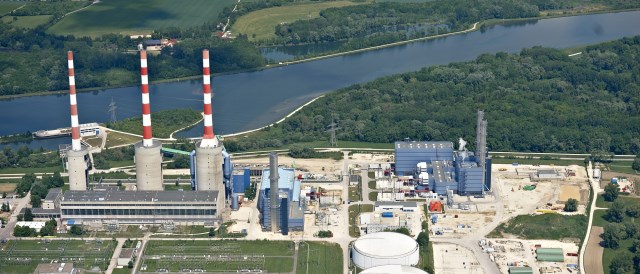The renewables sector is generally open to the idea of capacity payments, provided the design is “focused.” WWF Deutschland has already made such a proposal. Craig Morris provides an overview.

Irsching Power Station, a combined-cycle power plant that uses gas to produce both electricity and heat, for which reason it is more efficient than classical gas turbine plants. It is used as a peak load power plant and recently caused discussions as E.ON wanted to shut down one block due to unprofitability while the Federal Network Agency argued that its production capacity was needed to stabilize the grid. (Source: E.ON)
At present, wind and solar power are largely offsetting gas turbines, which are more environmentally friendly than coal plants. Chancellor Merkel recently stated that she is worried about the profitability of gas turbines but wants to prevent a situation where “each gas plant has to be subsidized.”
The general feeling in Germany is that full-blast capacity market, where all plants receive payment based on installed capacity, is undesirable and would distort the market. One option proposed by Germany’s Environmental Agency last summer, which we mention here, would be to provide funding for peaking power plants that only make up five percent of total demand, meaning that the remaining 95 percent would still have to compete on the energy-only market.
Last October, the WWF Deutschland published a proposal on a new power market design in cooperation with a number of consultants, most prominently the Öko-Institut. The entire 100-page paper is here (PDF) in German; a 17-page summary was also translated into English (PDF).
Everyone wants to keep the cost down. After all, we are talking about renewable power (with relatively high upfront costs and negligible fuel costs) reducing the capacity utilization of fossil and nuclear facilities (with lower upfront costs and higher fuel costs), which then require further subsidies. So the WWF also wants to ensure that capacity payments do not reduce competition.
One main difference is that the WWF wants to take account of carbon emissions; for example, the study proposes a maximum emission value of 600 g of CO2 per kilowatt-hour for new plants, which would essentially mean that gas turbines are eligible, but no coal plants are (neither hard coal or brown coal). Likewise, existing plants already running at sufficient capacity would not be eligible, which would predominantly affect nuclear and coal.
But the study goes further to include demand management. Here, firms (and, theoretically, households) could receive some kind of payment in return for a shift in power demand. The result would be lower peaks – “peak shaving.” A similar policy has been in practice for a long time in industry, where it is known as “load shedding,” only that now the times at which such shedding and shifting occurs would be based on what the grid needs.
And then there is the European level, which is also an energy-only market at present. You might think that European power trading would actually increase supply security and reduce the need for national capacity markets, but the authors write:
“The analyses of the shortage situations that have occurred so far show clearly that for Germany, the integration of the electricity market has caused more problems than it has alleviated, at least as regards regional security of supply. It is by no means possible to determine whether cross-border electricity sharing makes a positive or negative overall contribution to security of supply. It cannot necessarily be assumed that it helps Germany to safeguard security of supply.”
The authors conclude that “Germany needs to ensure it has sufficient national capacity to meet national load peaks… and that there may be demand for export capacity on top of this.” EU Energy Commissioner Oettinger, who says he is working to get member states to abandon their national energy policies in favor of greater EU harmonization, might not like the sound of that conclusion.
Obviously, I can’t do justice to a 100-page summary in this brief space, so read the 17-page summary for yourself for more information. In my next installment, I take a look at one German parliamentarian’s summary of what’s being discussed among politicians in Berlin.
Craig Morris (@PPchef) is the lead author of German Energy Transition. He directs Petite Planète and writes every workday for Renewables International.